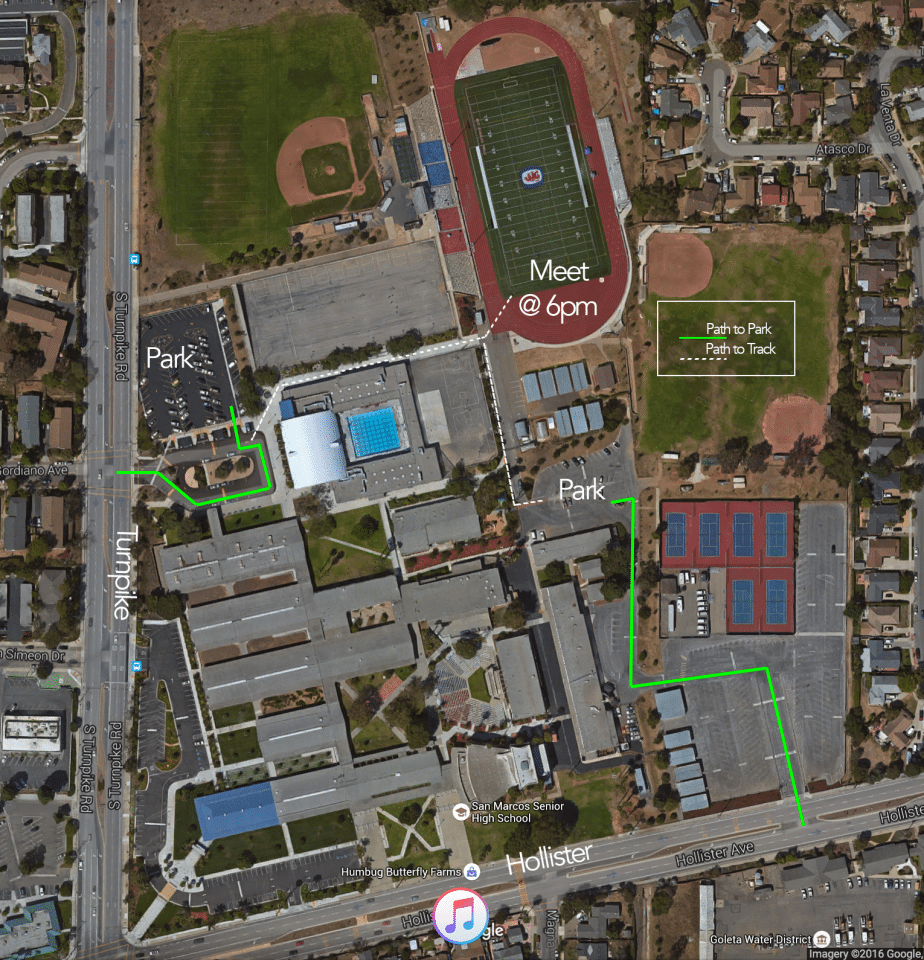When?
Starts Tuesday March 22 at 6pm!
View Full list of track dates!
Where?
San Marcos High School.
Google Map Here
Tuesday Night Run Workout
To be the best Triathlete you can be,
swim with the faster swimmers,
bike with the faster cyclists,
and run with the faster runners.
For 2016, SB Tri Club is changing the Tuesday night “track” workouts to incorporate more than just speed work on the track, but some fast interval work off-track, some hill work. As such, Tuesday “track” workouts will be more aptly called the Tuesday Night Run.
The Tuesday Night Run will refocus on short, hard work on the track, reminding all what it truly means to run hard, execute speed work, and train anaerobically. Tuesdays will cover the fundamentals including track etiquette, how to run a pace, how to use Heart Rate Monitors (HRMs) to help pace workouts, and what it means to run in HR Zone 5, and how a hard run workout fits into your weekly training schedule.
The off-track work will take knowledge of pacing and how to use a HRM to help you build consistency into your longer training intervals with longer repeats and the proper recovery times between intervals, and we’ll continue further off-track and do some short hill repeats.
Why speed work?
- To develop aerobic capacity/V02 max capability
- To improve anaerobic/lactate threshold HR
- To become a faster runner
Who should attend?
- Everyone should attend! People that have never done a track workout before, people that haven’t started building their running base, runners well into their running season, and you “senior” runners, looking to regain form
- Special attention will be paid to the inexperienced by providing veteran track runners the first several weeks to help pace the groups and explain how to run on the track
- Experienced runners will be given sets equal to their capability, pushing them to improve
- For those athletes that are “AARP eligible”, special attention will be given to your workouts to accommodate the needs of the aging athlete, and no, that doesn’t mean running slower and easier, quite the opposite it turns out!
Where will we meet?
- We’ll start at the San Marcos High School track, back behind the gym off Turnpike Road
- Off-track dates are TBD, but we’ll meet along the Obern Trail bikepath in Goleta (the south end of Turnpike Road), and along the beachfront in Santa Barbara
When do the workouts start?
- Tuesdays from March 22 through August.
What time do they start?
- Meet at 6PM, ready to warm up, at least 10 minutes or one mile
- At 6:15 we’ll go over the workout for the night, answering any quick questions
- Then we’ll do some drills and strides before breaking up into our groups, based on our pace per mile
The three things you need to bring:
- A stopwatch or preferably a HRM (and the knowledge on how to use it)
- Your minute/mile time for a 5k or 10k run race (times from a triathlon are ok too)
- The desire to run hard
One of the most common mistakes triathletes make in their training is
running too hard on easy days
and running too easy on hard days.
Helpful Hints
HRM Data Fields
If you have a watch or HRM that has customizable data screens, I recommend a screen with at least the following three data fields:
- Lap Time
- Lap Pace
- HR (current HR)
If you can add more fields, these two are also helpful:
- Pace (current Pace)
- Average HR
What’s my Lap Pace?
We run on a 400 meter track but we base our intervals on a minutes/Mile pace, which isn’t 100% accurate.
A 400m track is slightly shorter than a 440 yard track (437.45 yards actually, 8’4 25/64” shorter), welcome to America.
Your time for one lap will be your min/Mile pace divided by 4.
When determining the pace a group should run, based on the relative minute/mile pace in the group, it’s easiest to round those numbers up or down to the nearest 20 seconds.
- For example, instead of trying to figure out what one 400m lap based on an 8:25 pace should be, round it down to 8:20, divide by 4, and use 2:05 minutes as the lap interval
- For say an 8:37 pace, round up to 8:40, yielding a 2:10 lap interval
- It doesn’t have to be exact, close enough is good enough
The track is marked every 100 meters, so the group leader should call out the time at the 100 and 200m marks to keep track of and determine if the group is on pace for the lap and immediately adjust the pace. Holding to the pace is imperative!
If you are 1.25 seconds faster for every 100m run, that equates to 5 seconds/lap, or 20 seconds/mile faster. If you are running hard, HR Zone 5, that kind of pace can probably not be maintained for the entire set, so pay attention to the pace from start to finish so that you can finish the complete set as written.
Track Etiquette
- Warm up and cool down laps are run in the outside lanes, 5-8
- Fast laps are run in the inside lanes
- Don’t run more than two people abreast to allow people to pass easily
- If a faster group is approaching you from behind and someone yells “Track!”, move out a lane or two to let them by, to allow them to pass in the shorter distance more quickly.
- Note to fast runners, you should only call “Track” on your fast laps, don’t abuse it
- Don’t stand around on the track
For more info, questions, concerns about the Tuesday Night Run Workout, contact Fred. Email him at fredmaggiore@yahoo.com.

